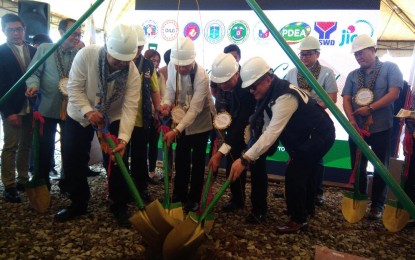
GROUNDBREAKING RITES. From left: Cavite Governor Jesus Crispin Remulla, Japanese Ambassador to the Philippines H.E. Koji Haneda, JICA Chief Representative Yoshio Wada and Health Undersecretary Roger Tong-An break ground and lower the time capsule for the construction of a DOH-Drug Abuse Treatment and Rehabilitation Center (DATRC) in Cavite under the “Programme for Consolidated Rehabilitation of Illegal Drug Users (CARE) Project” funded by the Government of Japan through the Japan International Cooperation Agency (JICA) in a five-hectare lot in Barangay Osorio in Trece Martires City on Thursday (July 19, 2018). (Photo by Gladys S. Pino, PNA)
TRECE MARTIRES CITY, Cavite – A 5-hectare complex with 25-building drug abuse treatment and rehabilitation center (DATRC) will rise in Barangay Osorio here to cater to illegal drug users/surrenderers and drug dependents from the Calabarzon Region following the groundbreaking ceremony on Thursday.
Department of Health (DOH) Undersecretary for Administration and Finance Cluster Roger Tong-an and Japan International Cooperation Agency (JICA) chief representative Yoshido Wada, with Japanese Ambassador to the Philippines H.E. Koji Haneda, Provincial Governor of Cavite Jesus Crispin Remulla, and DOH Calabarzon Director Eduardo C. Janairo, broke ground and lowered the time capsule to the expansive rehab facility complex.
The construction of the DOH-DATRC is a component of a JPY 1.850-billion DOH-JICA program grant called “Consolidated Rehabilitation of Illegal Drug Users” (CARE), a bilateral project in line with the Japan-Philippines Joint Statement on Bilateral Cooperation to combat illegal drugs, as part of the efforts to uphold public safety.
“I am glad to mention that both our governments finalized a mid-and-long term action plan on cooperation measures against illegal drugs that will set our paths towards the right direction over the next five years,” said Ambassador Haneda.
The joint Philippine-Japan efforts will pay close attention to enhancing prevention of drug abuse and relapse, “which we hope will ultimately lead to poverty alleviation,” the Japanese envoy added.
Tong-an, for his part, shared that Thursday’s groundbreaking event, is an explicit manifestation of DOH’s unflinching dedication and value for human life.
“(This is) a reflection of our vision to attain a resilient and drug free nation in compliance to the President’s three marching orders to DOH: war on drugs, war on corruption and to take care of the poor Filipino people,” Tong-an said.
JICA’s Wada said the executive agency of Japanese Official Development Assistance (ODA) supports DOH’s efforts in rehabilitating drug dependents and integrating them back to society through the DATRC.
To complement CARE, JICA is also implementing a technical cooperation with DOH, called Introducing Evidence-based Relapse Prevention Program to Drug Dependents Treatment and Rehabilitation Centers (IntERIaPP).
IntERIaPP aims to establish an evidence-based relapse prevention model to strengthen the capacity of Filipino health providers on drug dependence treatment.
The CARE Project, Janairo explained, aims to “enhance the facilities and policies of treatment protocol for drug users by establishing and upgrading facilities and reforming policies for treatment preventions.”
As to its location, Janairo was told of eight areas offered for the project but Remulla, who also chairs the Calabarzon Regional Peace and Order Council (RPOC), succeeded “by giving us the attributes necessary for a place like this.”
Remulla explained that he offered to host the project since drug addiction damages families and forever scars the human psyche.
“We offered to host a drug rehabilitation facility of the DOH because we know that we have to give hope for the families or the people that were victimized by drug addiction, for the possible rehabilitation and reconnection of people who are addicted to illegal drugs,” he said.
For the Cavite facility, Janairo shared about the DOH's intent to apply the five developed modalities in Mimaropa (Mindoro, Marinduque, Romblon and Palawan), namely alternative medicine, acupuncture, herbal and some therapeutic mentoring and coaching.
Although the modalities were applied on a community level, they can be applied in an in-house facility like the Cavite DATRC.
The soon to rise Cavite facility also promises a bigger arena for various services, since three hectares will be dedicated for treatment and rehabilitation center, while the remaining two hectares will house the mental health facility.
The Cavite DATRC will have complete amenities and facilities such as Medical Service Building, Activity Center, Training Center, Transition After Care Building, Administrative Building, Recreational Area, Prayer Hall, including a 100-bed allocation for future expansions.
The facilities are due for completion by July 2020, in time for the month’s annual observance of the Philippines-Japan Friendship Day.
Also gracing Thursday’s groundbreaking event were other DOH officials such as DDAPTP Program Manager Dr. Ivanhoe Escartin and Provincial Health Team Head Dr. Suki Jimenez; Cavite 6th District Representative Luis A. Ferrer IV; and host site Barangay Osorio Chair Joselito A. Marquez.
Members of the steering committee also attended the occasion with DILG Undersecretary Epimaco Densing, Department of Budget and Management Undersecretaries Agnes Joyce Bailen and Benjamin Reyes; Office of the President Asst. Secretary Aurora Ignacio; Director Jan Kenneth L. Bolante of Department of Foreign Affairs; Presidential Communications Operations Office Asec Ramon Cualoping III; Deputy Provincial Director for Administration Supt. Michael Siscillano; and PDEA Agent Melvin Estoque . (PNA)
